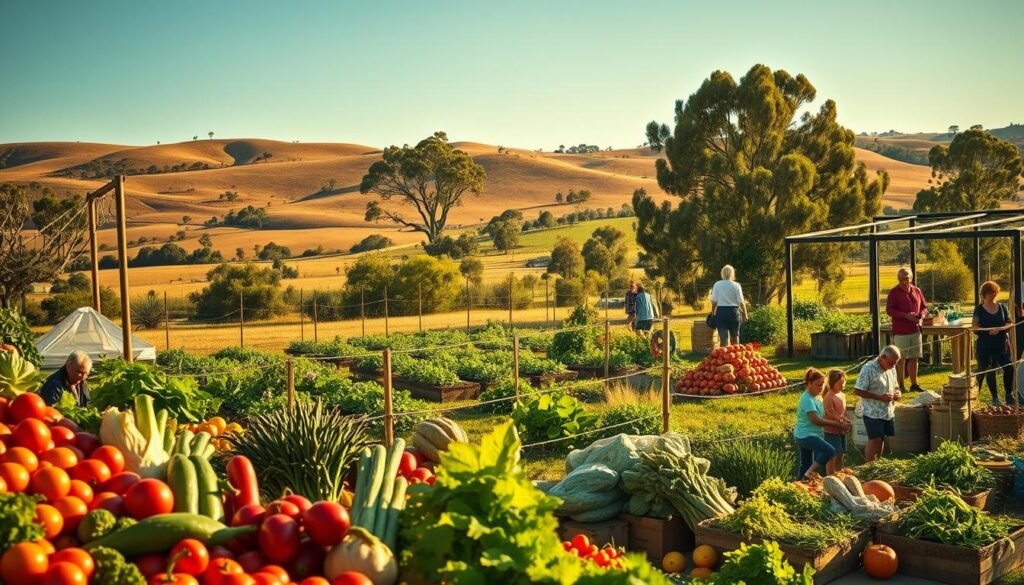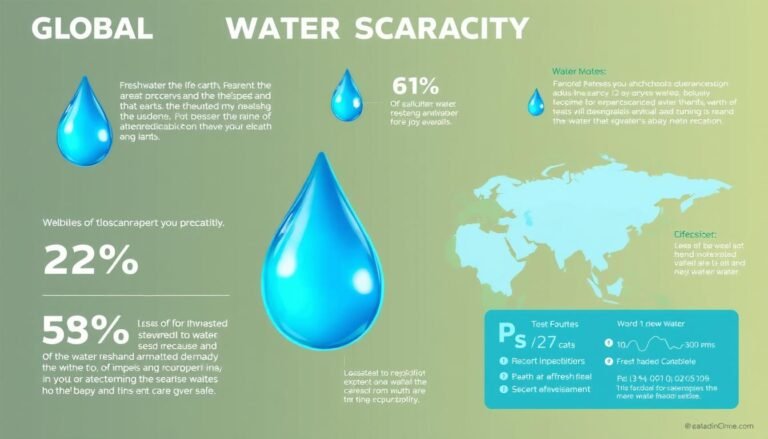Adopting sustainable eating practices is crucial for both personal well-being and the health of our planet. In Australia, the way we choose to eat not only affects our health but also has significant environmental implications.
As Australians become more aware of the impact of their food choices, there’s a growing shift towards healthier and more environmentally friendly eating habits. This article explores the importance of making informed decisions about what we eat, highlighting the benefits for both individuals and the environment.
Key Takeaways
- Understanding the impact of food choices on health and the environment.
- Exploring sustainable eating practices in the Australian context.
- Identifying simple changes to adopt healthier and more environmentally friendly habits.
- Recognising the benefits of sustainable eating for individuals and the planet.
- Discovering resources to support a transition to sustainable food habits.
The State of Food Sustainability in Australia
The state of food sustainability in Australia is a complex issue, intertwining environmental, social, and economic factors. As we navigate the challenges of climate change, water scarcity, and land degradation, it becomes increasingly clear that our food choices have a significant impact on the planet.
Current Environmental Challenges
Australia’s food systems are facing significant environmental pressures. The production, processing, and distribution of food contribute to greenhouse gas emissions, water usage, and land degradation.
Climate Impact of Australian Food Systems
The climate impact of Australian food systems is substantial, with agriculture being a significant contributor to the country’s emissions. Reducing the carbon footprint of our food is crucial for mitigating climate change.
Water Usage and Land Degradation
Water usage and land degradation are also pressing concerns. Efficient water management practices and sustainable land use are essential for maintaining the health of our ecosystems.
Health Implications of Our Food Choices
Our food choices not only affect the environment but also have significant implications for our health. The Australian Dietary Guidelines provide a framework for making informed choices.
The Australian Dietary Guidelines and Sustainability
The Australian Dietary Guidelines emphasize the importance of a balanced diet, rich in whole foods and low in processed foods. Aligning our diets with these guidelines can have numerous health benefits.
Connecting Diet to National Health Outcomes
There is a clear link between diet and national health outcomes. By making sustainable food choices, Australians can reduce the risk of chronic diseases and improve overall well-being.
Sustainable Food Habits Australia: A Comprehensive Guide
Sustainable food habits are not just a trend; they’re a necessity for a healthier Australia and a healthier planet. As we navigate the complexities of modern eating, understanding what makes food sustainable is crucial.
What Makes Food Sustainable?
Food sustainability encompasses various factors, including environmental impact, social responsibility, and economic viability. Sustainable food habits in Australia involve making conscious choices that benefit both our health and the planet.
Environmental Footprint Considerations
The production, processing, and distribution of food have significant environmental implications. Choosing locally sourced, seasonal produce can reduce carbon emissions associated with transportation. Eco eating in Australia means being mindful of the environmental footprint of our food choices.
Social and Economic Factors
Sustainable food systems also consider the welfare of farmers and food producers. Fair trade practices and supporting local farmers contribute to a more equitable food system. By choosing sustainable food options, Australians can promote social justice and economic stability in the food industry.

The Triple Bottom Line in Australian Food Systems
The triple bottom line approach evaluates the sustainability of food systems based on environmental, social, and economic outcomes. This holistic view is essential for creating a truly sustainable food culture in Australia.
Indigenous Food Knowledge and Practices
Australia’s indigenous communities have long practiced sustainable food gathering and production methods. Incorporating indigenous food knowledge can enhance the sustainability of modern Australian food systems.
Modern Applications of Traditional Wisdom
By combining traditional indigenous practices with modern technology and innovation, we can develop more sustainable food production methods. This blend of old and new can lead to more resilient and environmentally friendly food systems.
As we move towards a more sustainable food future, it’s clear that sustainable food habits in Australia will play a crucial role. By understanding and applying the principles of food sustainability, Australians can contribute to a healthier environment and a more equitable food system.
Eating Locally and Seasonally
As Australians, we have the opportunity to enjoy a varied diet by eating locally and seasonally, supporting our environment and local farmers. This approach not only enhances the freshness and quality of our food but also contributes to a more sustainable food system.
Benefits of Australian Local Food Systems
Eating locally reduces the carbon footprint associated with transporting food over long distances. It also supports local economies by directly benefiting farmers and producers. Some key benefits include:
- Freshness and Flavor: Local produce is often picked at the peak of freshness, ensuring better taste and nutritional value.
- Economic Support: By buying locally, consumers directly support local farmers and contribute to the local economy.
- Environmental Benefits: Reduced transportation needs lower emissions, contributing to a cleaner environment.
Seasonal Eating Guide for Australian Climates
Australia’s diverse climates mean that seasonal produce varies significantly across regions. Understanding what’s in season can help you make the most of local food systems.
Summer and Autumn Produce
In summer, enjoy fresh fruits like mangoes and berries, while autumn brings delicious apples and pears. These seasons offer a vibrant array of produce.
Winter and Spring Produce
Winter is the perfect time for citrus fruits and root vegetables, while spring brings a variety of leafy greens and asparagus. Each season offers unique flavors and textures.
Finding Farmers’ Markets and Food Trails
To fully embrace local and seasonal eating, explore your local farmers’ markets and food trails. These hubs offer a chance to connect with producers and discover new flavors. Some tips for finding them include:
- Searching online for “farmers’ markets near me” or “food trails in [your region].”
- Asking locals or checking community boards for recommendations.
- Using social media to find events and markets in your area.
By embracing local and seasonal eating, Australians can enjoy a more sustainable, flavorful, and community-driven food culture.
Reducing Food Waste in Australian Households
The problem of food waste in Australia is multifaceted, requiring a comprehensive approach to mitigate its effects. As Australians become more aware of the importance of eco eating Australia, reducing food waste at home is a significant step towards a more sustainable lifestyle.
The Scale of Food Waste in Australia
Australia faces a significant challenge with food waste, with millions of tons of food being discarded annually. This not only has environmental implications but also economic ones, as wasted food represents a loss of resources and money for households.
Practical Food Storage and Preservation
Proper food storage and preservation are key to reducing waste. By organizing your fridge effectively and using appropriate preservation techniques, you can extend the shelf life of your groceries.
Fridge Organisation Tips
Keep your fridge at the right temperature, store food in airtight containers, and ensure that older items are consumed before they expire. This simple practice can significantly reduce waste.
Freezing and Preserving Seasonal Bounty
Freezing seasonal produce is an excellent way to enjoy your favorite fruits and vegetables year-round while reducing waste. Consider blanching vegetables before freezing to preserve their nutritional value.
Creative Ways to Use Leftovers and Scraps
Being creative with leftovers not only reduces waste but can also lead to delicious new meals. Australian cuisine offers a variety of inspiration for using leftovers.
Australian-Inspired Leftover Recipes
Transform last night’s dinner into tomorrow’s lunch by incorporating it into a salad or wrapping it in a tortilla. You can also use vegetable scraps to make a hearty soup or stock.
Composting Solutions for Different Living Situations
For those with gardens, composting is a great way to turn food scraps into nutrient-rich soil. Even without a garden, you can compost using worm farms or bokashi bins, making it accessible for urban dwellers.
| Food Item | Storage Tip | Preservation Method |
|---|---|---|
| Berries | Store in airtight containers in the fridge | Freeze or make into jam |
| Vegetables | Keep in the crisper drawer, wrapped in paper towels | Blanch and freeze or pickle |
| Bread | Store at room temperature or freeze | Make croutons or breadcrumbs |
By implementing these strategies, Australian households can significantly reduce their food waste, contributing to a more sustainable food culture that aligns with the principles of eco eating Australia.
Plant-Based Eating: A Sustainable Choice
The shift towards plant-based eating is gaining momentum in Australia, driven by its potential to enhance both personal health and environmental sustainability. As the nation grapples with the challenges of climate change and environmental degradation, adopting sustainable food habits is becoming increasingly important.
Environmental Benefits of Plant-Forward Diets
Plant-based diets are known to have a lower environmental impact compared to diets high in animal products. By choosing plant-forward meals, Australians can significantly reduce their carbon footprint. According to a study published on PMC, plant-based diets can lead to reductions in greenhouse gas emissions and water usage.
- Reduced greenhouse gas emissions
- Lower water usage
- Less land degradation
Incorporating More Plants into Your Australian Diet
Transitioning to a more plant-based diet can be straightforward and delicious. Australians can start by adapting traditional meals to include more plant-based ingredients.
Adapting Traditional Aussie Meals
Classic Australian dishes like meat pies and burgers can be easily adapted by substituting meat with plant-based alternatives. For instance, using lentils or mushrooms can add flavor and texture.
Easy Swaps and Substitutions
Simple swaps, such as choosing plant-based milk or opting for vegetarian protein sources, can make a significant difference. Some easy options include:
- Replacing beef with tofu or tempeh
- Using lentils or chickpeas in soups and stews
- Choosing whole grain over refined grains
Australian Native and Locally-Grown Plant Proteins
Australia is rich in native and locally-grown plant proteins that can enhance the nutritional value of plant-based diets.
Legumes and Pulses Grown in Australia
Legumes such as lentils, chickpeas, and beans are not only nutritious but also environmentally friendly. They are widely grown in Australia and can be incorporated into a variety of dishes.
Bush Foods and Indigenous Plant Proteins
Australia’s indigenous foods, such as kangaroo beans and native greens, offer unique flavors and nutritional benefits. Exploring these options can add diversity to plant-based meals.
By embracing plant-based eating, Australians can contribute to a more sustainable food system while enjoying a diverse and nutritious diet.
Sustainable Meat and Seafood Options
Embracing eco-friendly eating habits in Australia involves exploring sustainable meat and seafood options. As consumers become more environmentally conscious, the demand for responsibly sourced protein is on the rise.
Ethical Meat Consumption in Australia
Ethical meat consumption is about making informed choices that support animal welfare and sustainable farming practices. In Australia, consumers can look for certifications that ensure high standards are met.
Understanding Certifications and Labels
Certifications like Organic and Free Range indicate that the meat is produced under certain standards. Understanding these labels helps consumers make informed choices.
Supporting Regenerative Farming Practices
Regenerative farming focuses on improving soil health, biodiversity, and ecosystem services. By supporting such practices, Australians can contribute to a more sustainable food system. Key practices include:
- Rotational grazing
- Organic amendments
- Minimal tillage
Sustainable Seafood Guide for Australians
Australia’s coastal waters offer a diverse range of seafood, but not all options are sustainable. Making informed choices is crucial for marine conservation.
Local Species and Seasonal Choices
Choosing local and seasonal seafood can significantly reduce the carbon footprint associated with transportation. Australians can opt for species that are abundant and well-managed.
Avoiding Overfished Species in Australian Waters
Some seafood species are overfished, threatening marine ecosystems. Australians can check the Australian Marine Conservation Society website for guidance on sustainable seafood choices.

By choosing sustainable meat and seafood options, Australians can enjoy a healthy diet while supporting the planet’s well-being. It’s about making conscious choices that benefit both personal health and the environment.
Growing Your Own Food in Australian Conditions
Cultivating your own edible garden is a practical way to contribute to sustainable food habits in Australia, regardless of where you live. By growing your own food, you not only have access to fresh, nutritious produce but also play a part in reducing your carbon footprint.
Benefits of Home Food Production
Growing your own food offers numerous benefits, including improved food security, reduced reliance on industrial agriculture, and the opportunity to cultivate a wide variety of fruits and vegetables suited to your local climate.
Getting Started with Climate-Appropriate Gardens
To start, it’s essential to choose plants that are well-suited to your local climate conditions. Water-wise gardening techniques can help minimize water usage, while incorporating native edibles can add diversity to your garden.
Water-Wise Gardening Techniques
Implementing drip irrigation and mulching can significantly reduce water waste.
Native Edibles for Your Garden
Consider planting native Australian foods like Kakadu plum or Davidson’s plum for a unique and sustainable harvest.
Urban Farming Solutions for City Dwellers
For those living in urban areas, there are still plenty of opportunities to grow your own food. Balcony gardens and community gardens offer city dwellers a chance to cultivate their own produce.
Balcony and Small Space Gardens
Utilize vertical gardening techniques and compact varieties to maximize your space.
Community Garden Opportunities
Joining a local community garden can provide not only a plot of land but also a community of like-minded individuals.
Sustainable Food Shopping Strategies
Australians can significantly reduce their ecological impact by implementing sustainable food shopping habits. This involves making informed choices that not only benefit personal health but also contribute to the well-being of the planet.
Navigating Australian Food Labels and Certifications
Understanding food labels is crucial for sustainable shopping. Australian labels can sometimes be confusing, but knowing what to look for can make a big difference.
Organic, Free-Range and Other Claims
Labels such as “organic” and “free-range” have specific meanings. Organic refers to produce grown without synthetic fertilizers or pesticides, while free-range indicates that animals have been given some access to the outdoors.
Country of Origin Labelling
Country of Origin Labelling helps consumers make informed decisions about the products they buy. Look for labels that indicate where the food was grown or produced.
Reducing Packaging Waste
One of the simplest ways to make food shopping more sustainable is by reducing packaging waste. Here are some strategies:
- Choose products with minimal or biodegradable packaging.
- Buy in bulk to reduce single-serving packaging.
- Use reusable bags and containers for shopping.
Bulk Food Stores Across Australia
Many Australian cities now have bulk food stores where consumers can buy exactly what they need, reducing waste.
Reusable Packaging Solutions
Investing in reusable packaging solutions, such as beeswax wraps or cloth bags, can significantly cut down on single-use plastics.
Supporting Ethical Australian Food Businesses
Supporting local and ethical food businesses is another key aspect of sustainable food shopping. Look for businesses that prioritize fair trade, sustainable farming practices, and community involvement.
By implementing these sustainable food shopping strategies, Australians can make a positive impact on the environment while also enjoying healthier, more ethical food choices.
Community Initiatives and Resources
Sustainable food habits are gaining traction in Australia, thanks to numerous community resources and initiatives. These programs are crucial in supporting individuals and families in their journey towards more eco-friendly eating practices.
Food Co-ops and Community Supported Agriculture
Food co-ops and community-supported agriculture (CSA) programs are becoming increasingly popular in Australia. These initiatives allow consumers to purchase fresh, locally grown produce while supporting local farmers.
Finding Local Food Networks
To find local food co-ops or CSA programs, Australians can search online or visit local farmers’ markets. Many communities also have social media groups dedicated to sustainable food practices.
Starting Community Food Initiatives
For those interested in starting their own community food initiatives, there are resources available. Organizations such as the Australian Food Co-op Alliance provide guidance and support for establishing food co-ops.
Educational Programs and Resources
Educational programs play a vital role in promoting sustainable food habits. These programs range from workshops on sustainable gardening to cooking classes focused on plant-based diets.
Australian Sustainable Food Organisations
Several organizations in Australia are dedicated to promoting sustainable food practices. The Sustainable Food Network, for example, offers a range of resources and educational materials.
Workshops and Courses Near You
Australians can find workshops and courses on sustainable food practices through local community centers, online platforms, and environmental organizations. These educational opportunities help individuals develop the skills needed to adopt more sustainable eating habits.
| Initiative | Description | Benefits |
|---|---|---|
| Food Co-ops | Community-run grocery stores that sell fresh, locally sourced produce. | Supports local farmers, reduces carbon footprint. |
| Community Supported Agriculture (CSA) | Programs that allow consumers to purchase shares in a farm’s produce. | Provides farmers with upfront capital, offers consumers fresh, seasonal produce. |
| Educational Workshops | Cooking and gardening classes focused on sustainable food practices. | Equips individuals with skills to adopt sustainable eating habits. |
Conclusion: Your Journey Towards Sustainable Eating
Embracing sustainable food habits is a powerful step towards a healthier environment and personal well-being in Australia. By understanding the state of food sustainability, adopting a comprehensive guide to sustainable eating, and making conscious choices, individuals can significantly impact the planet.
Simple yet effective sustainable diet tips AU include eating locally and seasonally, reducing food waste, and incorporating more plant-based meals. Exploring sustainable meat and seafood options, growing your own food, and adopting sustainable food shopping strategies can further enhance your dietary habits.
Community initiatives and resources play a vital role in supporting individuals on their journey towards sustainable eating. By engaging with food co-ops, community-supported agriculture, and educational programs, Australians can foster a community that values healthy and sustainable food practices.
Start your journey today by implementing these sustainable eating habits and inspire others to do the same, contributing to a more environmentally friendly food culture in Australia.





